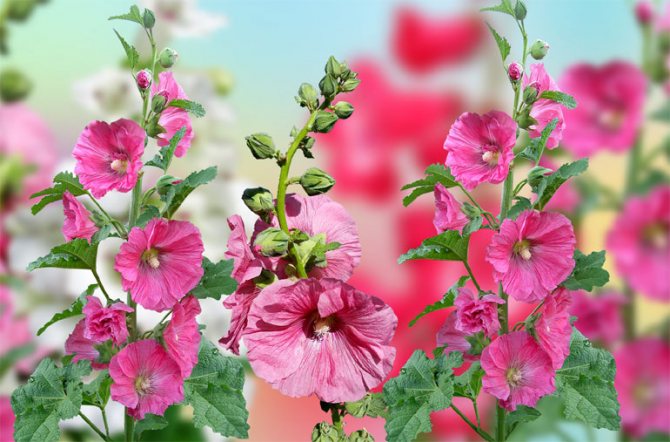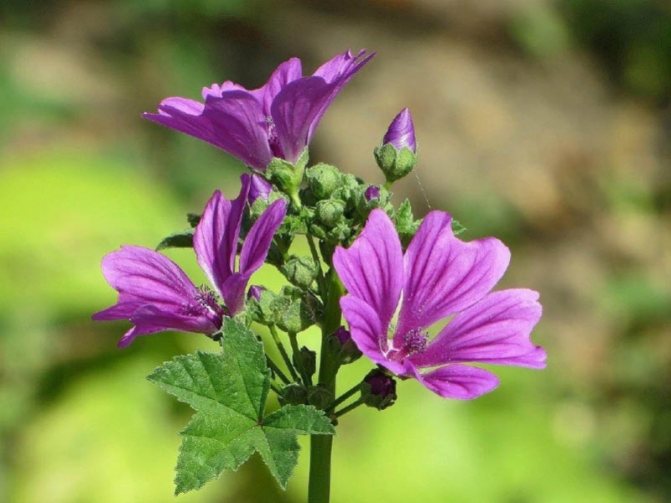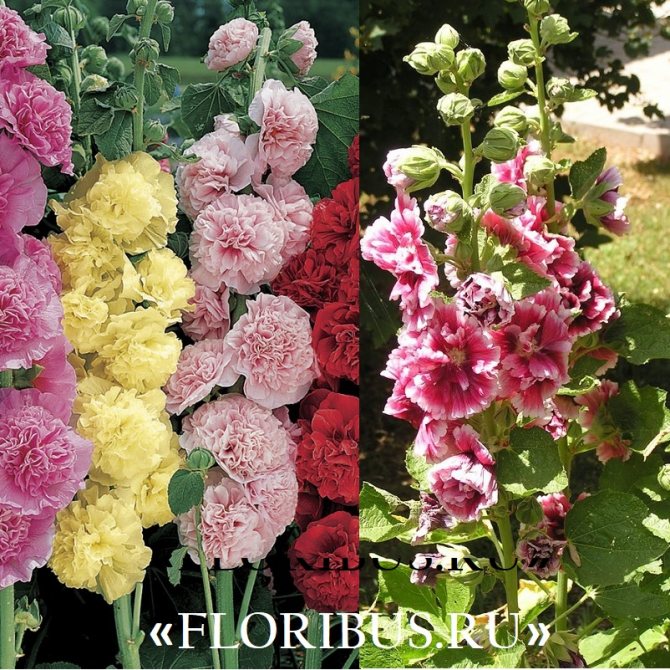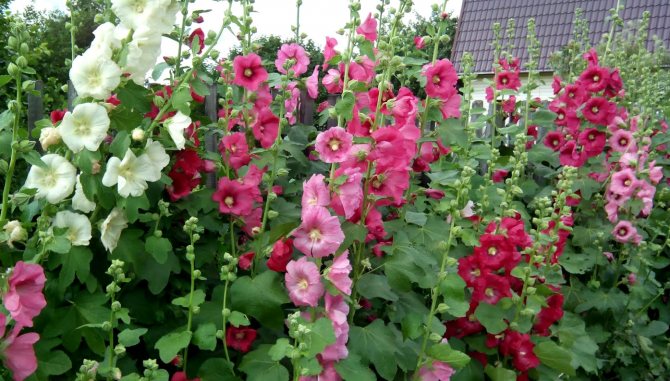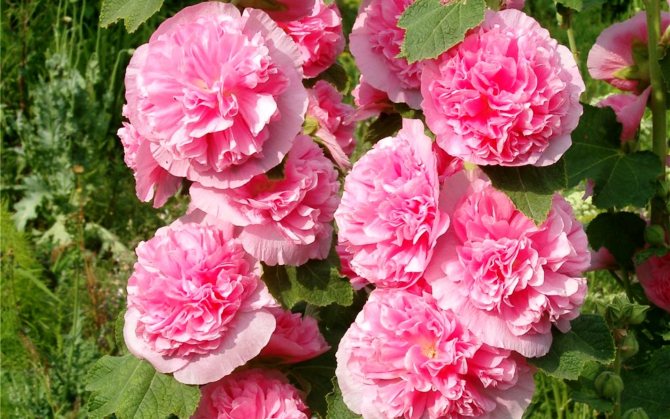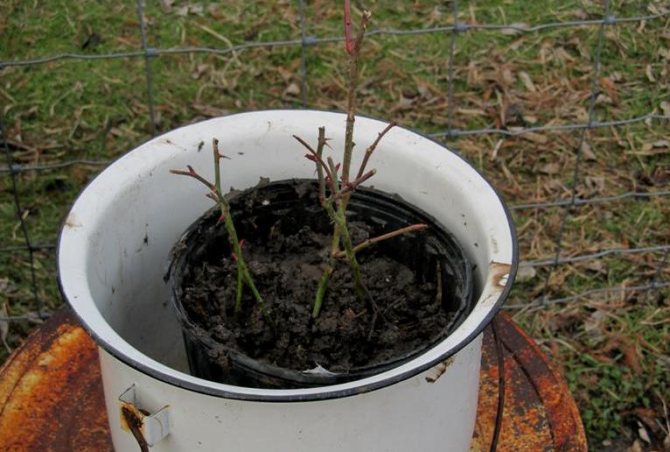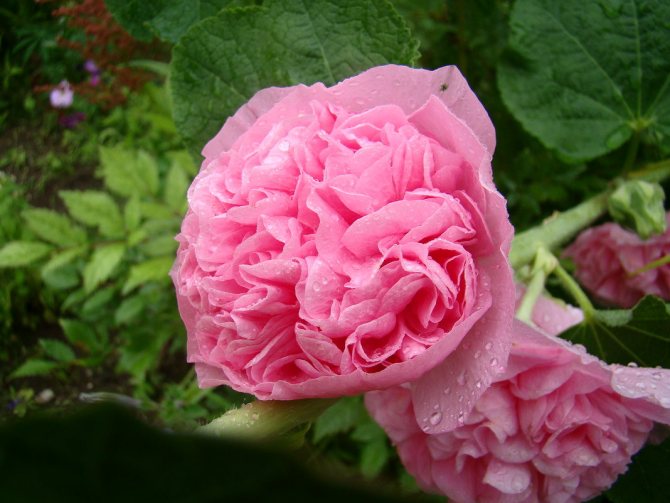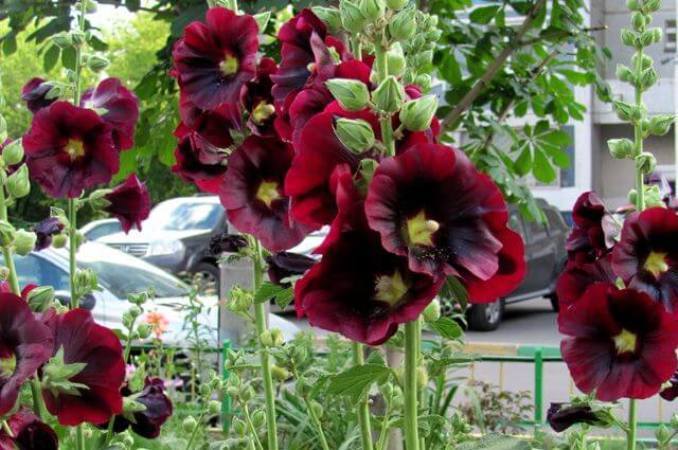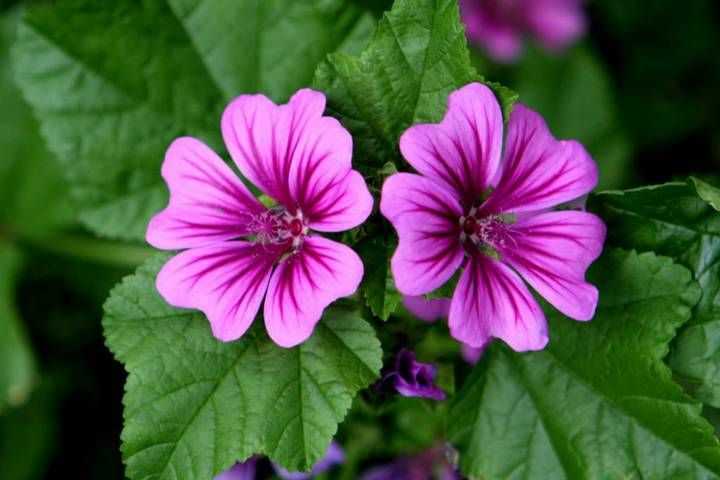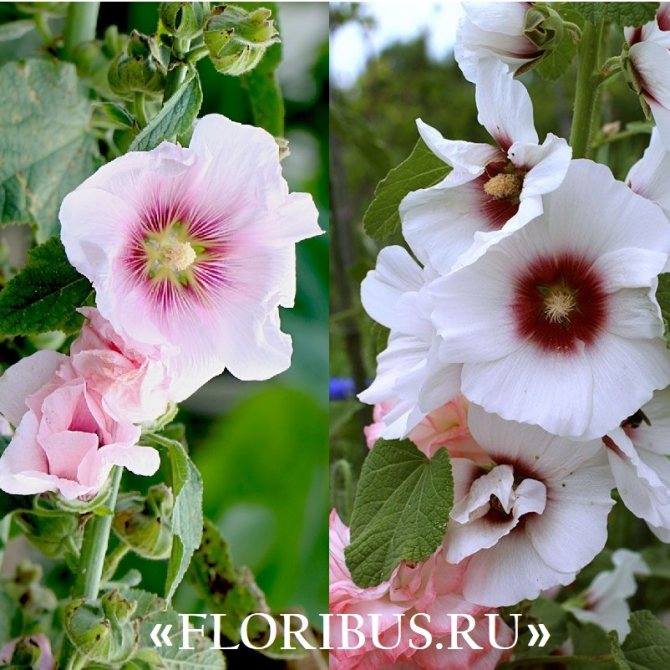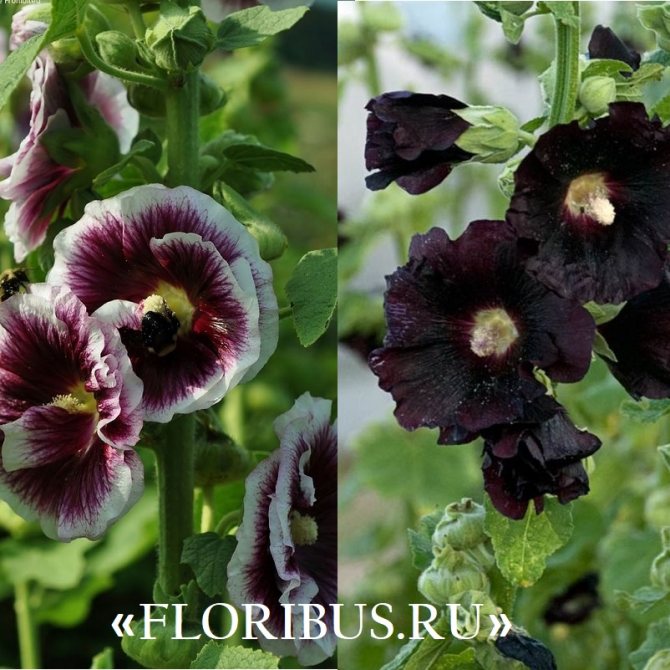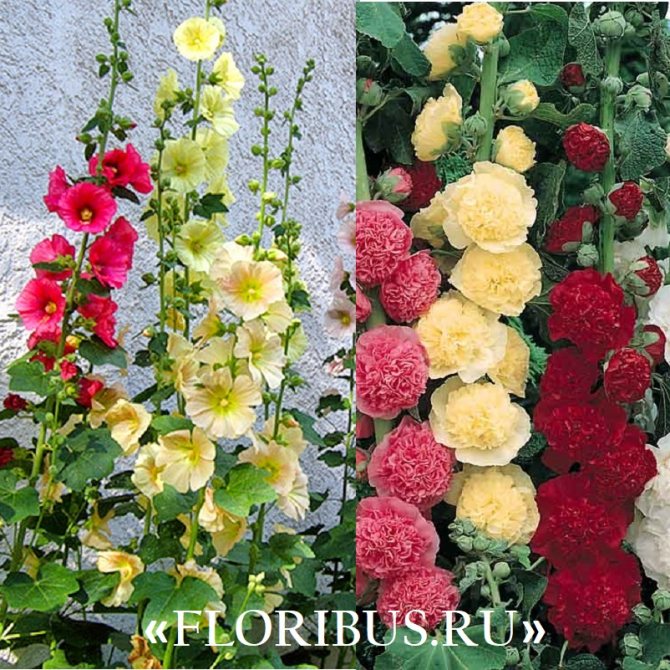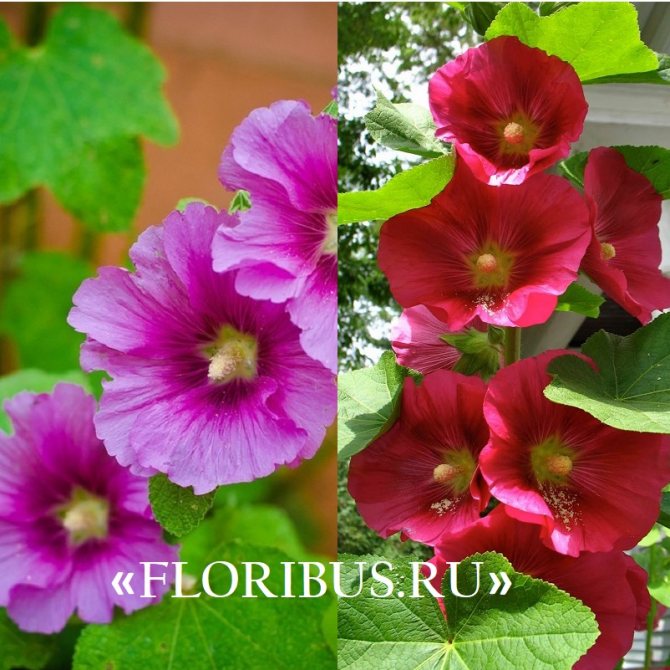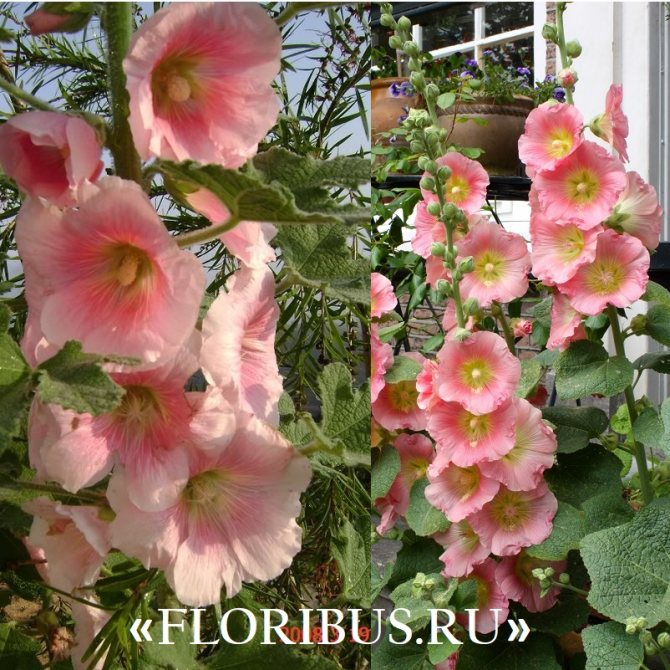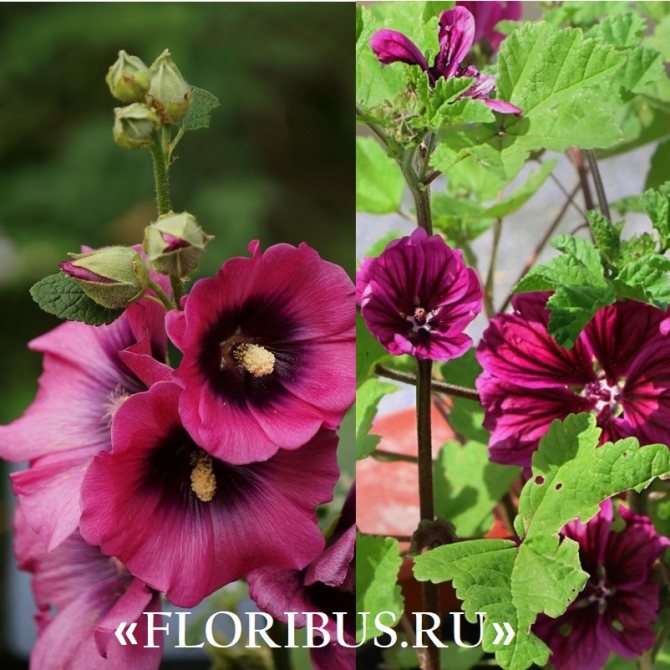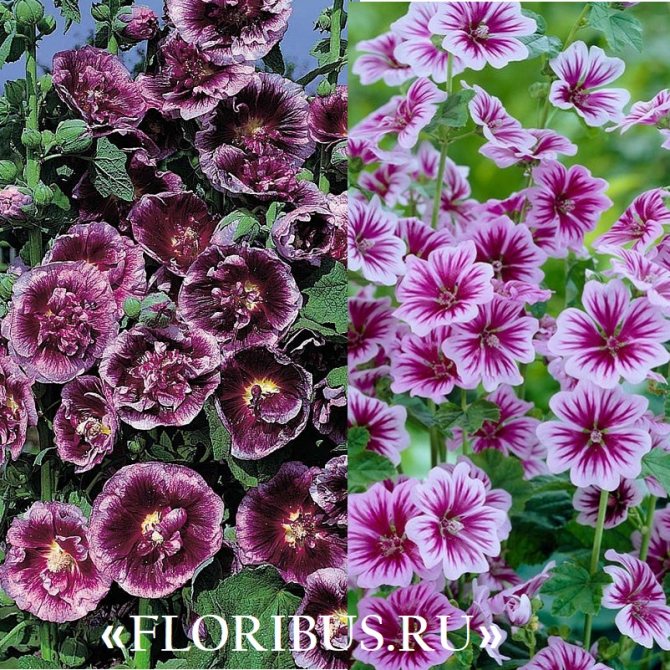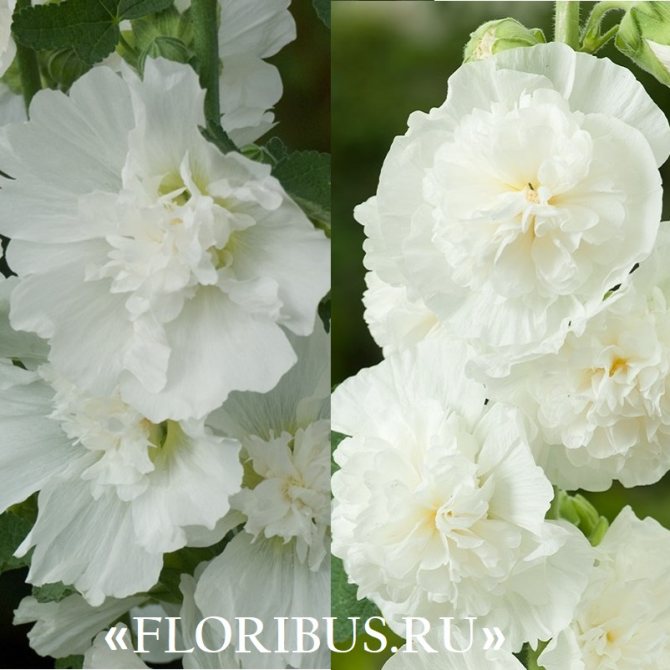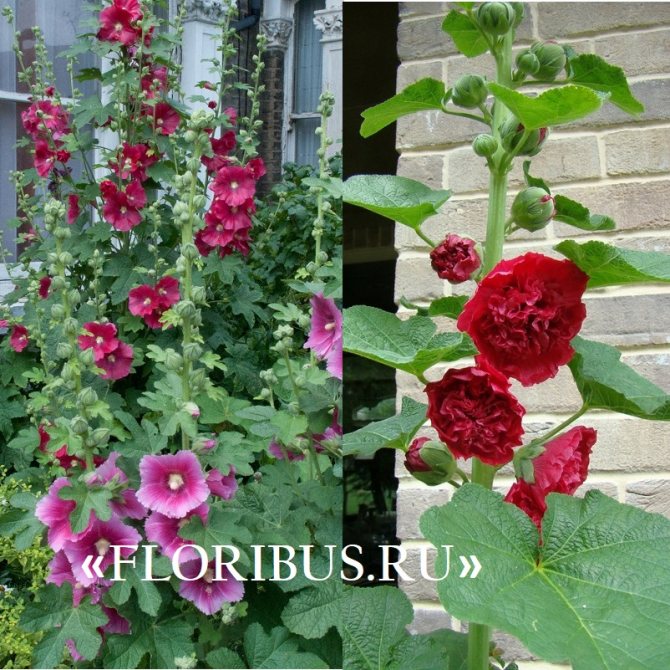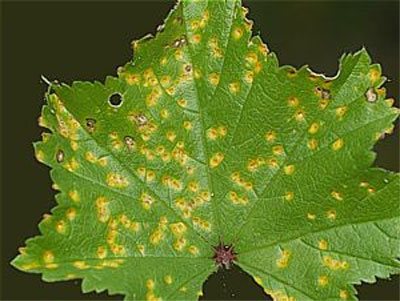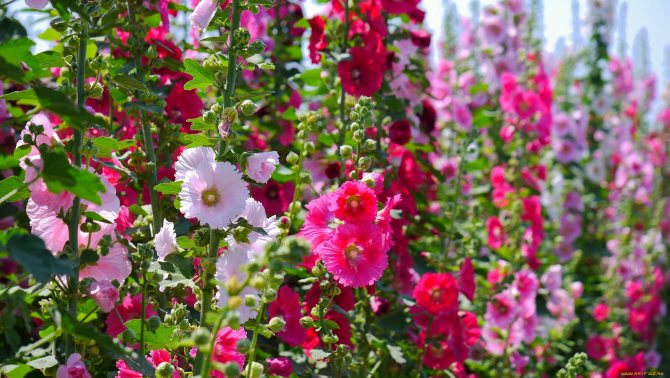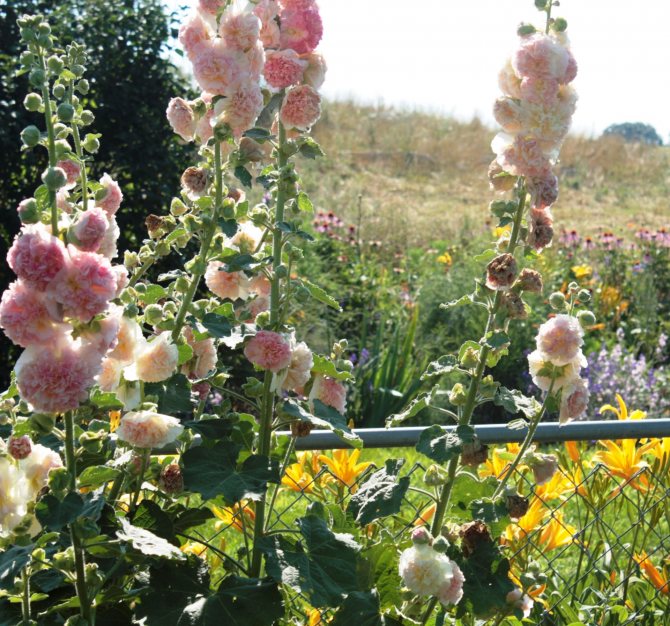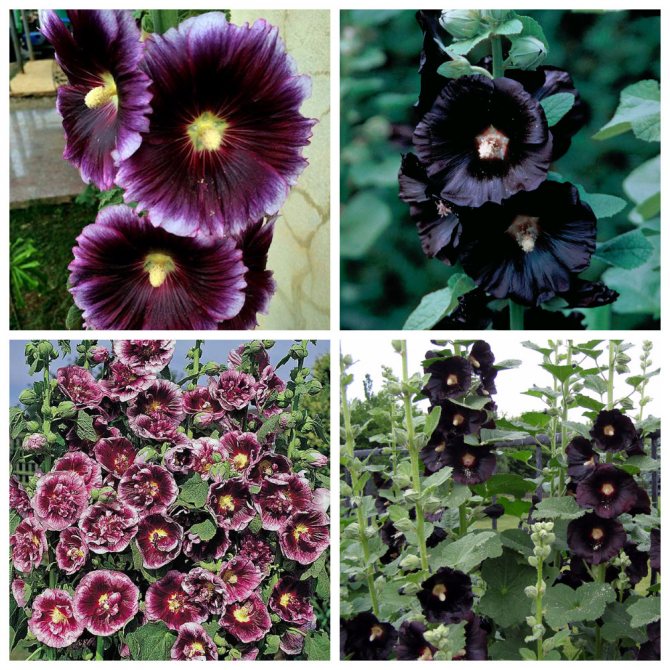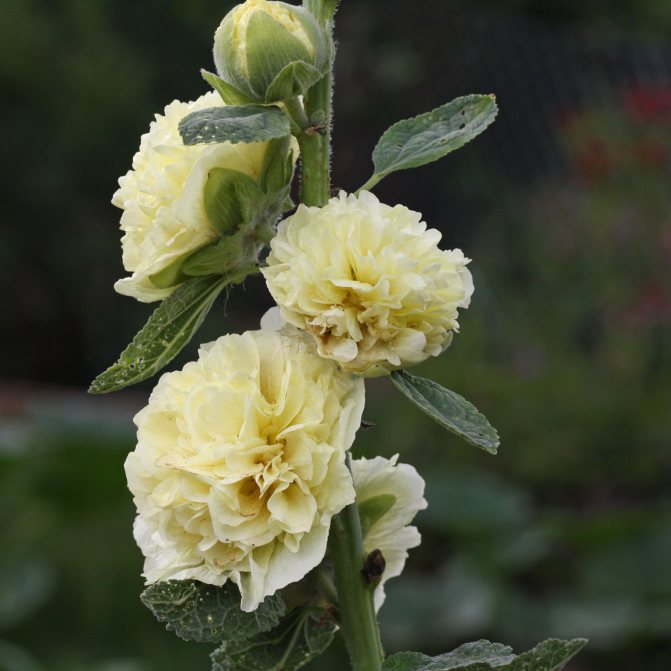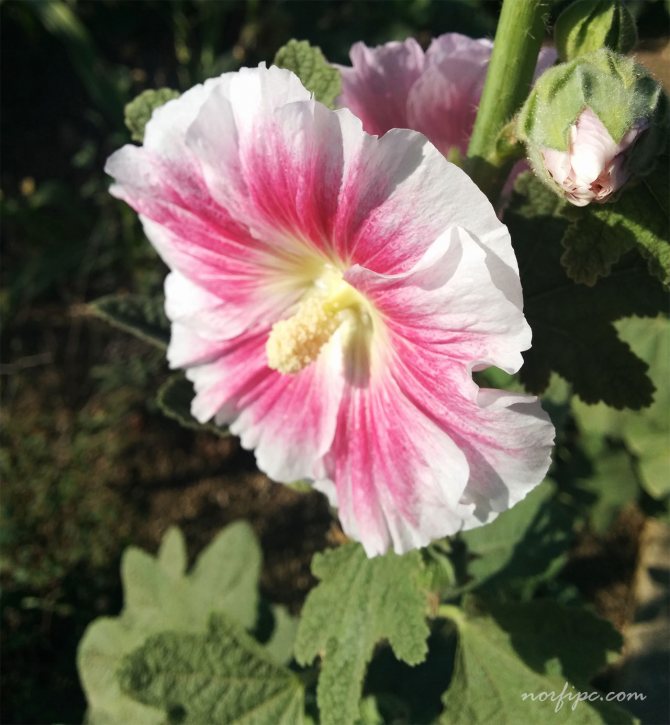Stockrose belongs to the flowers of the Malvaceae family. There are about 80 species of this beautiful plant. Most of them are perennials, but there are also annuals. Gardeners most often plant biennials on their plots, they require special care only at the beginning of the growing season. Stockrose can decorate any front garden, this ornamental plant is actively used to decorate garden plots, create beautiful flower arrangements. We will tell you more about the stock rose, growing it from seeds, when to plant these beautiful flowers.
Description of the plant
The Malvaceae family includes trees, shrubs, herbaceous plants, more than 4000 species in total. The family includes the subfamily Malvoideae Burnett, the popular representatives of which are:
- Alcea L. - Stockrose or mallow, has 77 species. It grows naturally in arid places, mainly in the Eastern Mediterranean region.
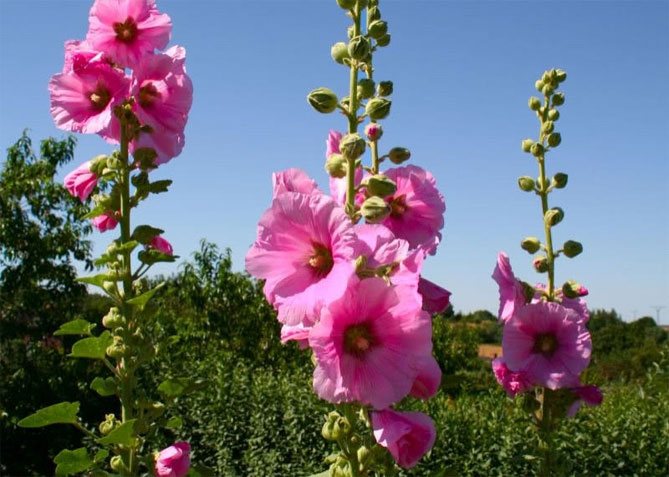
- Malva L. - Mallow or mallow, has about 25 species.
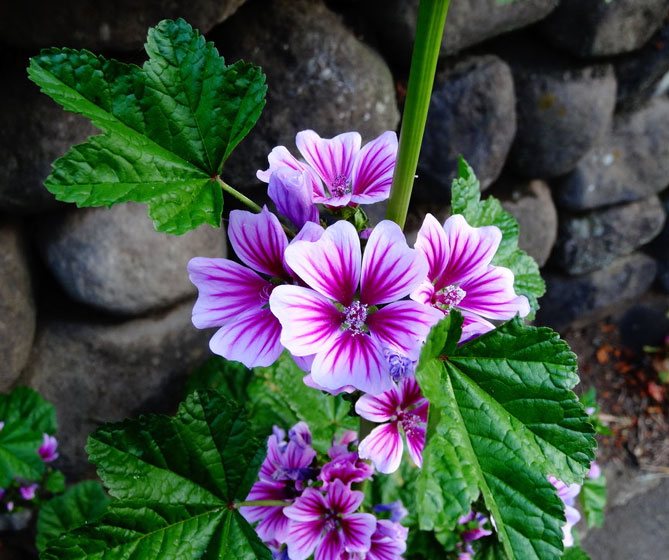

The tall and romantic perennial mallow flower is usually associated with rustic front gardens, romantic English-style gardens. Stockrose came to us from China, where the tradition of growing the plant goes back thousands of years. Plants look great in modern gardens without causing much hassle for gardeners.
In the 16th century, stockrose was brought to Europe from Palestine. The plant was given the Latin name Alcea in reference to the Greek word for "marshmallow" - to heal. The fascination with the beauty of stockrose gave way to its medical significance - flowers were used to heal people and horses. Unfortunately, a global epidemic of fungal rust in the late 19th century significantly reduced the number of mallow plants on all continents. Only in the 30s of the 19th century, gardeners again paid attention to the forgotten plant.
Stockrose is a perennial plant. However, due to its beautiful flowering at 2 years old and the attack on plants by rust, it is often considered a biennial.
Who is who
So, a little higher, we found out that from a scientific point of view, this "flower dispute" is meaningless - for a priori it is not enough for a clear delineation of the sounded information. However, gardeners are simple people, they usually do not care about taxonomy, so they construct their own "classification" (scientifically, they give their own, trivial names that allow them to unambiguously separate one plant from another by some essential characteristic for them. ).
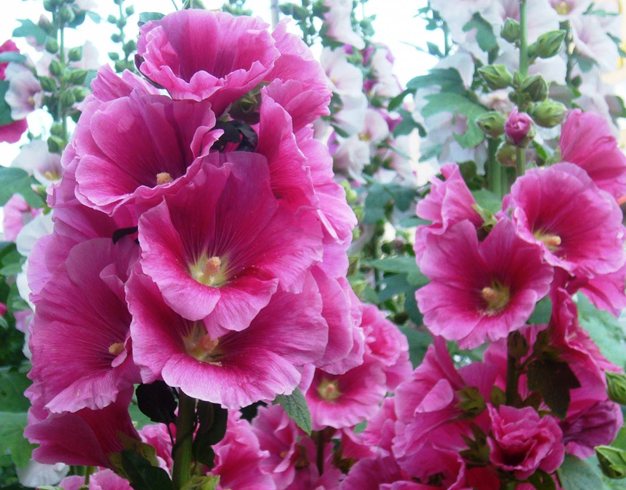

Let's analyze the used unscientific name "stock rose": it is clear that it combines the word "rose" (we all quite clearly imagine what it is) with the word stock (a literal borrowing of the German Stock, which means a stick or a rod). So, we are talking about some kind of "stick with roses" - but what does this have to do with the "mallow" habitual to us since childhood, which grows in summer in almost every domestic yard? Let us recall its appearance: a tall (often under two or three meters) plant with large five-petal flowers - "bells", which pollinating insects (especially bumblebees) love to visit. Its flowers are most often really pink in color - but they do not look like a real rose at all!
Types and varieties
This flower of considerable size, found in many different flowers, was grown in antiquity and is probably originally from China.The most popular types of ornamental mallow in the world:
- Pink (Alcea rosea),
- Crimean stock-rose (Alcea rugosa),
- Fig-leaved (Alcea ficifolia),
- Pale (Alcea pallida).
Decades of work in the cultivation of mallow have resulted in the creation of many attractive varieties and hybrids, of different heights, with semi-double and double flowers.
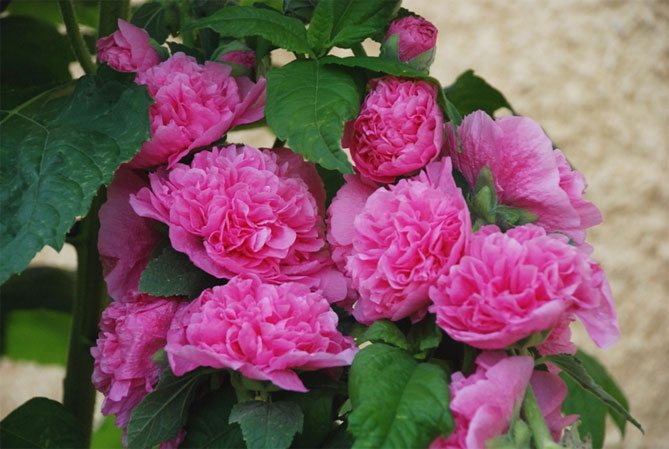

Pink stockrose
In our country, the most popular Pink Stockrose - Alcea rosea, is a biennial plant. Despite the name, the plant takes on different colors:
- yellow,
- salmon,
- white,
- cream,
- Orange.
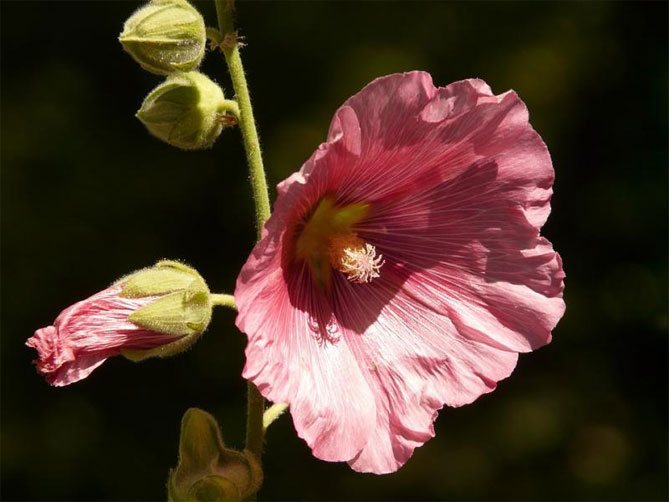

Particularly intriguing is the Black Rose (Alcea rosea nigra), a dark, almost black color.
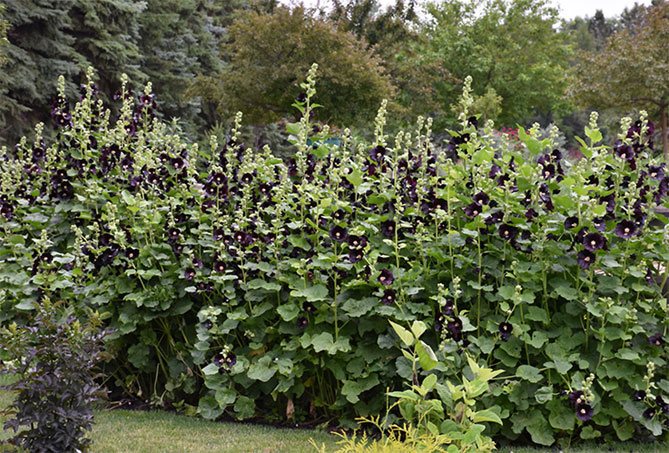

When does mallow bloom? The plant blooms profusely in the second year of life, from June to August.
Pink mallow has lobed coarse leaves with a diameter of 10-25 cm.According to the criterion of the structure of a flower, garden stockroses are divided into the following groups:
- Fimbriata flore pleno - slightly serrated leaves, semi-double flowers, rarely sit on the stem;
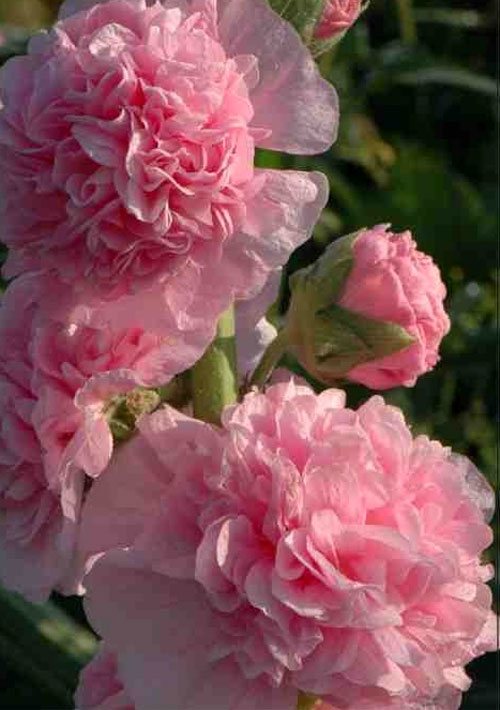

- Scottish - semi-circular flowers, petals of the same length, stem height - 2 meters;
- large perennial terry mallow - beautiful, double, "pompom" flowers, stems up to 3 meters high;
- chaters - characterized by a dense inflorescence, relatively low height.
The most interesting examples of pink stockrose:
- black mallow;
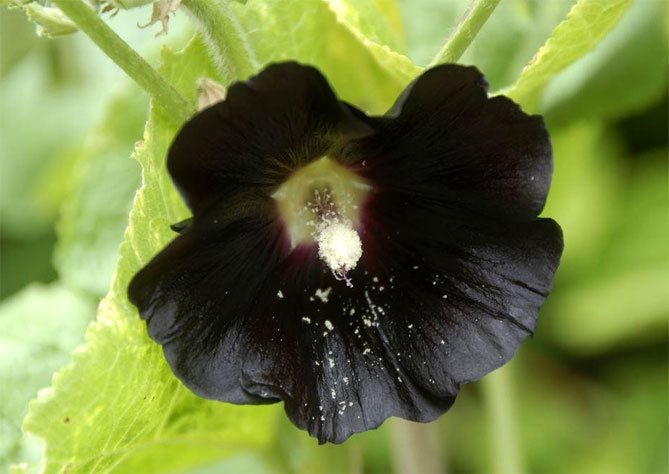

- variety "Creme de Cassis" - raspberry inflorescence;
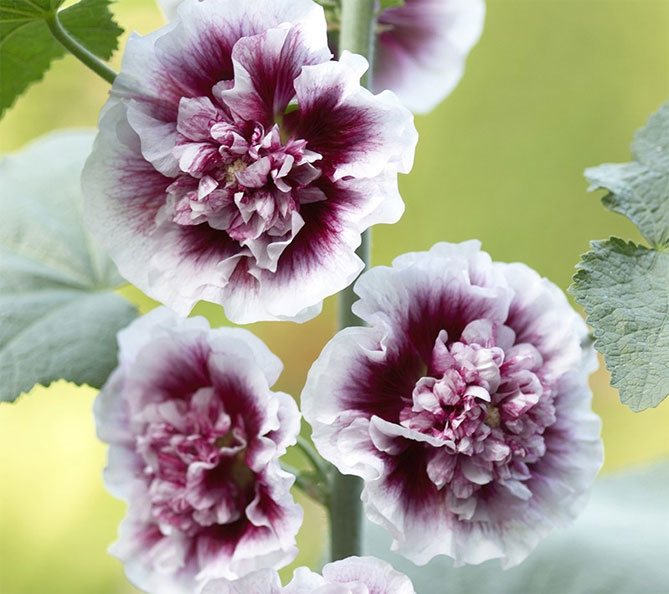

- Spring Celebrities Apricot - salmon flower
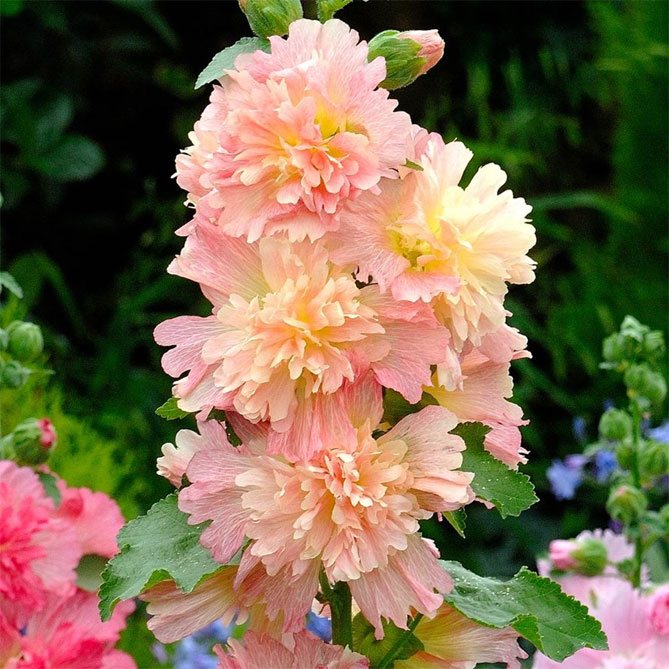

- Double Purple is a purple flower.
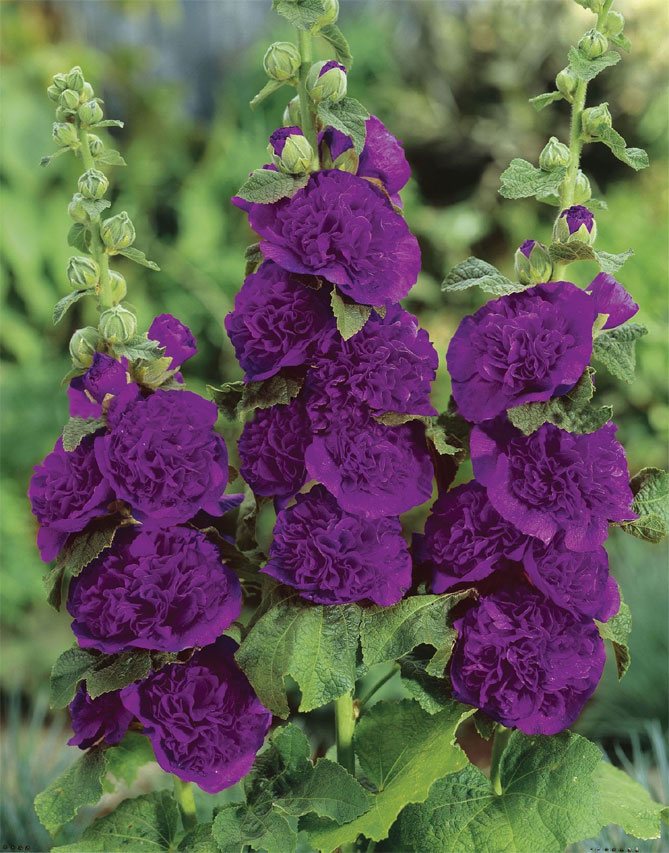

Figurative
Fig-leaved mallow is often found in gardens. It reigns in the tropical climate of Western Asia and Southern Europe. The variety is more resistant than pink.
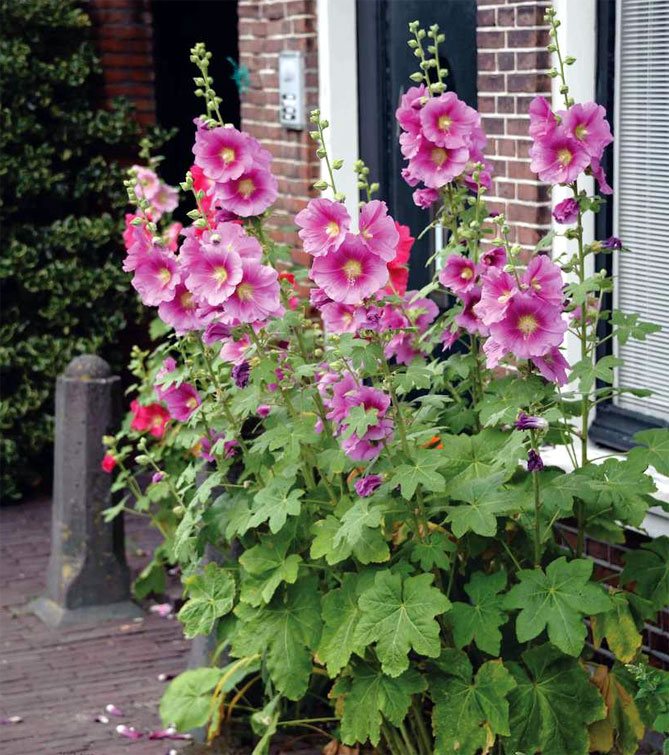

Crimean
The Crimean species (Alcea rugosa) is mostly yellow in color. This is an undemanding, frost-resistant stock-rose, originally from the south of Russia and Ukraine. Grows up to 2 meters. Large, round, bright yellow flowers appear from June to September. There are many hybrids of Crimean and pink stockrose.
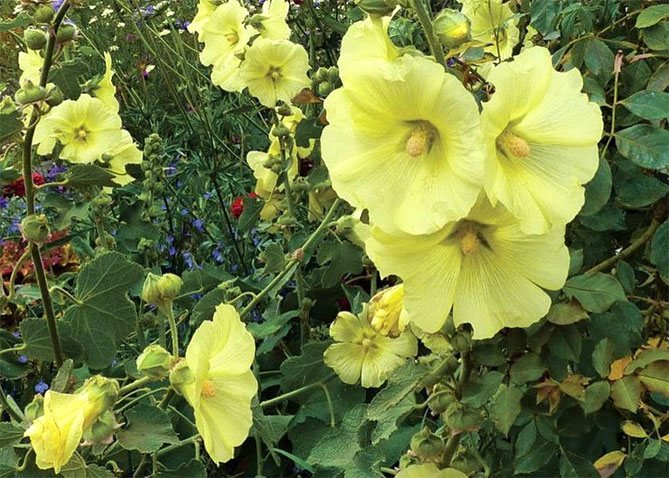

Reproduction
There are the following breeding methods for mallow:
- cuttings;
- seed;
- dividing the bush.
Terry perennials of roses are propagated by division or cuttings. Such methods completely ensure the preservation of varietal qualities, and in these cases double flowers will appear in a double rose. But reproduction by seeds does not guarantee the preservation of the variety and leads to the fact that the flowers will not have terry.
When grafting mallow in July, the shoots that have formed next to the main stem are cut off, after which they need to be rooted, creating greenhouse conditions (under a plastic bottle or film). In August, as the cuttings grow and take root, they are transplanted to the planned place of growth. It is imperative to cover for the winter.
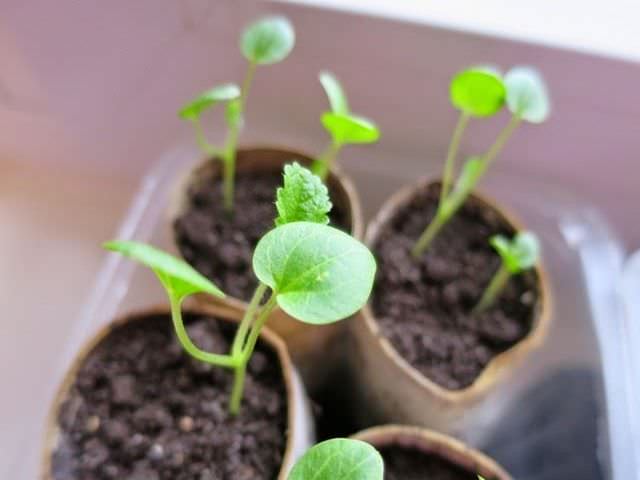

Common mallow can be propagated by seed. With good care and conditions, it tends to give viable shoots of natural regeneration. They should be carefully dug out with a lump of earth and transplanted to the right place.
Landing
Before growing mallow, you should prepare the planting site.
Choosing a suitable place, preparing the soil
First you need to choose a suitable position. The stock rose garden looks interesting in small and large gardens. The planting site is chosen warm, preferably sunny or perhaps a little shaded, but the plant can repay for unfavorable conditions with poor flowering. Due to the very long stems and large flowers, stockroses should be planted in places protected from the wind - strong gusts can lead to stem breakage.
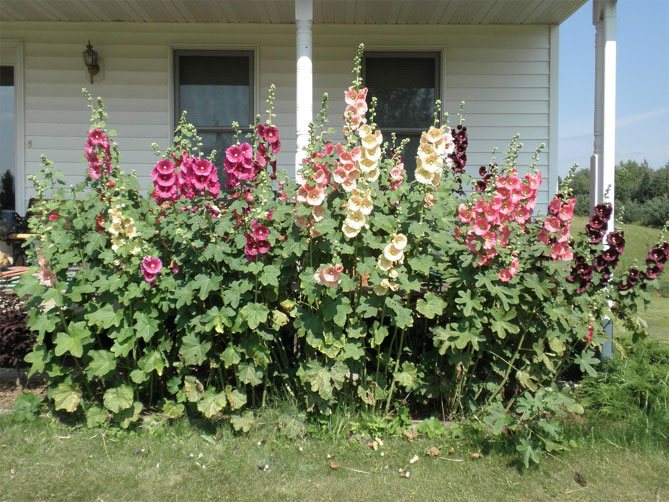

Plants are quite tolerant of growing conditions. They will withstand loamy, sandy soils, do not impose excessive requirements on the level of acidity of the substrate. They will flower best in fertile, permeable soil, so, if possible, they should be planted in flower beds with a little rotted compost and a little peat.
The soil needs to be weeded out, loosened up. The drainage layer is not required, but it will maintain the conditions of light moisture in the soil, which are optimal for stockroses. The addition of perlite or gravel improves the permeability of the soil.
Sowing
Planting mallow seeds is carried out from May to July, to a depth of 2 cm. You can sow in open ground, pots, boxes, protected by glass.The first shoots appear in a week.
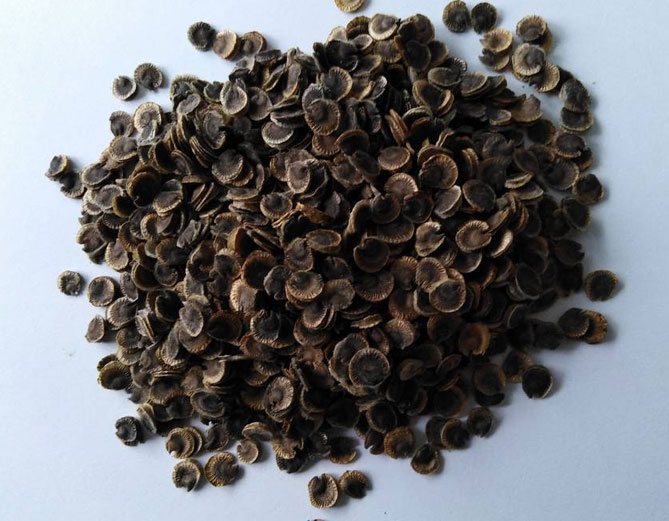

Seedlings of a pink rose stock (purchased or grown seedlings from seeds) are best planted in open ground in September - the plant will bloom next year, at the beginning of summer. When planting, a distance of 50-80 cm is observed between individual plants. No more than 5 plants are sown per 1 square meter. The flowering period is June-October.
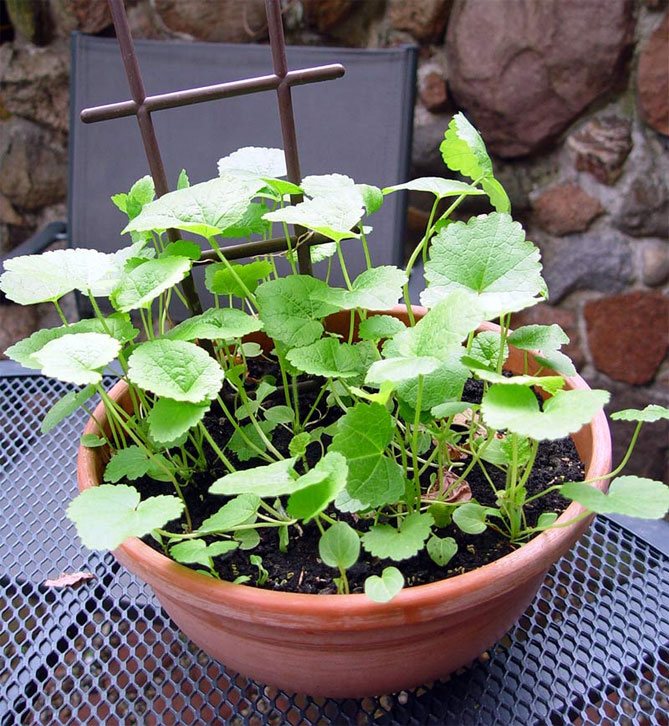

The leaves that grow in the first year create a solid rosette that looks very attractive. It is better to sow stockrose seeds in open ground from May to July, sowing depth - 2 cm. If you do not want to wait 2 years, you can plant annual varieties in March-April, they will bloom in summer, from July to September.
For germination of mallow seeds, a temperature of at least 20 ° C is required.
Sowing
Before sowing (14 days), it is necessary to prepare the soil by digging up the area intended for planting with a shovel with a seam turn. When digging from the soil surface, dry grass and roots should be cleaned and removed, after which mineral fertilizers are applied to the ground in a dose of 100 grams per square meter. meter.
It is recommended to plant seedlings in early June, preferably in open places with access to light. Mallow practically does not tolerate through winds. The planting is carried out in such a way that the roots have time to get stronger and fully start the growing season.
Plants planted on the sunny side will subsequently delight you with a rich color, mallow develops poorly in the shade, and its flowers are not so bright, but very demanding on the soil, so the soil should be humus, fertile and light in structure. On heavy clayey or light sandy loams, mallow can die.
If the planting takes place with the help of a root, then it must be treated with stimulating drugs "Kornevin", "Epin" or "Heteroauxin" for about 10 hours. These preparations are very effective and increase plant survival.
After that, a depression is prepared in the soil, a root is placed in it, which is covered with earth, watered and treated with mulch. Sawdust, peat or dry grass are used as mulch. When planting, you need to observe the gaps between the bushes of about half a meter.
Mallows, planting and care consists in the fact that the seeds are embedded in the soil in a glass or box. To obtain viable seedlings, seeds must be sown in March or early April. When the soil warms up, around May, the seeds can be sown in the ground.
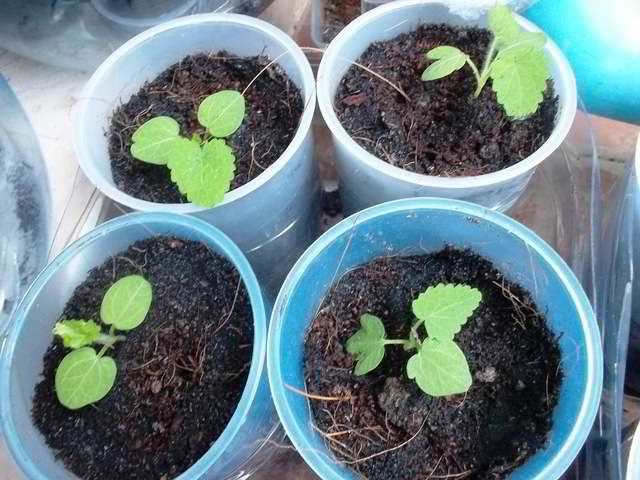

Basically, mallow is planted along the fence or supports for the bush. In mallow, the root system has a pivotal structure, as you know, the presence of such a system makes plants vulnerable, so it is better not to transplant, but initially plant in a separate peat pot, which can then be planted in the right place without any problems.
Growing and care
After planting, adequate care of the perennial rose stem is necessary. Initially, stockrose leaves develop, they form a round low rosette.
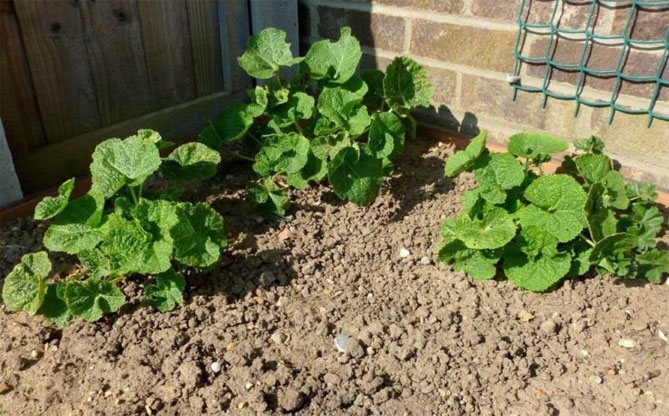

Then a thick, rough stem appears. Some stems reach a height of 3 meters. Gradually, they are densely covered with heart-shaped leaves. The diameter of the mallow flowers is 4-5 cm. The flowers are located in the upper part of the stem, on short stems in the leaf axils. The most beautiful and abundant flowers appear in the second year after planting.
Growing mallow is not difficult. Flowers are arranged on short stalks. To protect the shoots from breaking, you can tie them with a flexible garden cord. For protection from the wind, it is worth planting mallow under a fence, walls. It is necessary to take into account the considerable height of the stockrose - it can cast a shadow on other plants.
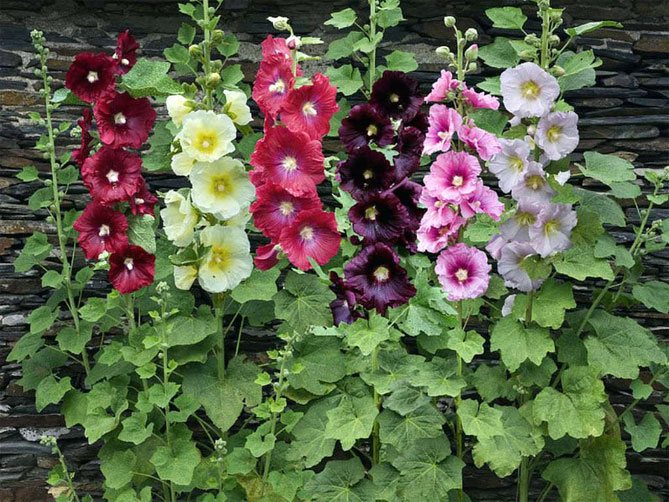

A special case is the black mallow, whose flowers are not visible from a distance. She is better off finding an extremely open place next to a road or path from where she can admire flowers up close.
During the first, non-flowering year, stockroses should be protected from weeds by covering the soil around with bark and regularly looking after the plant. Weeds compete for water and nutrients, affecting the health of flowers.
Watering
When growing mallow, care must be taken to optimally moisturize the soil. If the soil is too dry, the flower can become infected with a disease called rust. Rust spores appear on the underside of the leaf, and light spots appear on the top. If you do not apply the fungicide treatment in time, the plant may die.
In drought in hot summer, daily watering may be necessary. On hot summer days, you need to water the stockrose early in the morning and in the evening.
It is recommended to conduct a soil moisture test: if the top layer has dried at a depth of 1-2 cm, it's time to get the watering can.
Waterlogging of the earth is also dangerous. In too wet soil, stockrose can rot and fungal diseases can develop. The key to success lies not only in the amount of water, but also in the irrigation method. Mallow should not be sprayed, watered from above - this can damage large flowers and contribute to the development of fungal diseases. Water should be poured directly under the plant's root system, avoiding splashing leaves, ideally in the morning.
Avoid watering mallow during the midday heat. Each drop of water on the leaf turns into a lens, causing fatal burns.
Stockrose is often watered in the first year after planting. In subsequent years, you can water the flower only when the soil surface is dry.
Fertilization and feeding
Fertilizing is recommended, especially if the mallow grows in a poor substrate or pot.
Fertilizers are applied twice:
- the first dose of compost or liquid multicomponent fertilizer should be applied in the spring;
- the next one - during the flowering period.
Some sources recommend feeding every 2-4 weeks.
Removing wilted inflorescences
Taking good care of mallow requires the systematic removal of wilted flowers along with the shoots. Thanks to this, the flower releases new buds, the life of the plant increases to 4-5 years. Only the shoots from which it is planned to collect seeds are left.
On a note! Stockrose is easily pollinated with each other. Therefore, when growing a plant from seeds, it is difficult to obtain the expected color of flowers.
Autumn care, wintering
Mallows are frost-resistant, but young plants are best covered with mulch, leaves or agrofibre for the winter. Pink stockrose is winter-tolerant, so there is no need to cover it in the fall.
Seed collection
When summer ends, fruits with seeds appear at the bottom of the stem. After the fruits are ripe, the stem must be cut off at the base. This will allow the plant to focus its energy in preparing for winter. Thanks to this operation, the plant will be able to bloom profusely next year.
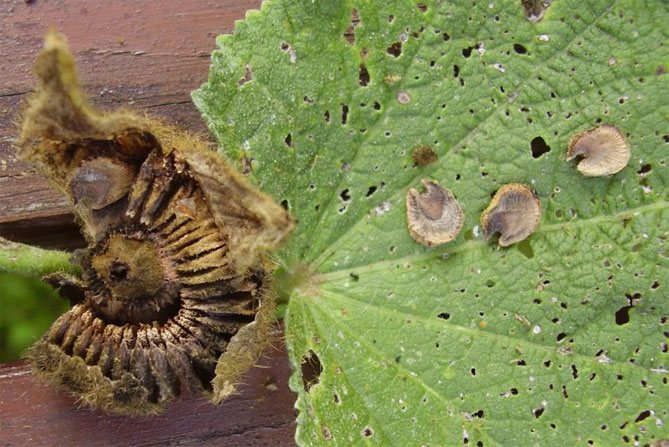

Transfer
In one place, stockrose can grow for 3-4 years. At the end of her "life", the seeds are collected and sown in a new place. Transplanting mallow is undesirable, the plant is sensitive to root injuries. Transplanting is safe only for very young plants.
Reproduction
A great advantage of mallow is the ability to self-seeding. Under favorable conditions, old plants naturally die, and new ones appear on the flower bed. If there are too many seedlings, they grow chaotically, interfering with each other, it is worth removing weaker plants.
A gardener who values control over landscape composition may want to plant new flowers to suit his taste. For this, seeds collected from faded inflorescences at the end of September are sown in a prepared place - directly on a flower bed, in soil dug up with compost.
Sowing is also possible in pots. Seeds germinate in 2-3 weeks, but stockrose will bloom only in the next calendar year.
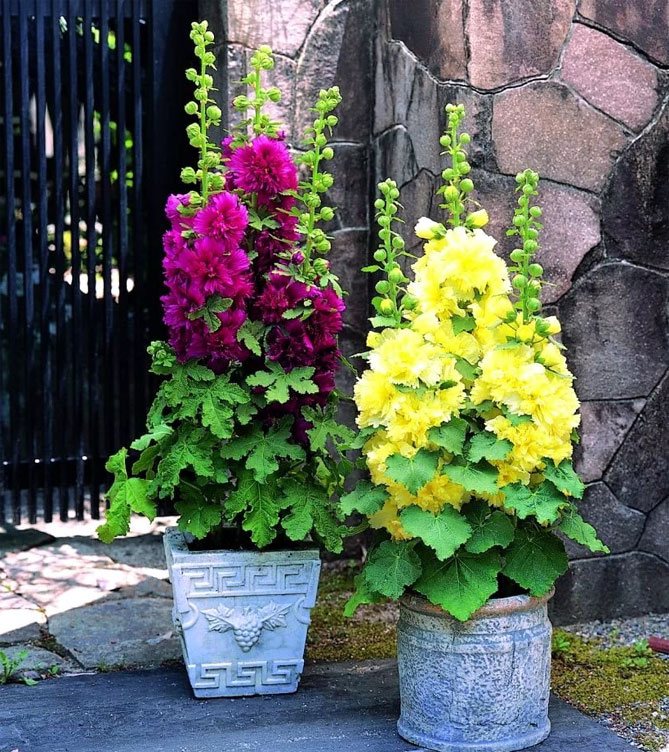

Presowing preparation of seed material
Regardless of whether you bought seeds or collected it yourself before sowing - they need to be processed, pre-sowing treatment includes the following activities:
- Analysis for the usefulness of seeds by calibration. To do this, the seeds are immersed in a 3% saline solution for 15 minutes. The floating seeds should be removed, and the settled seeds can be used in crops, since they are considered full-grain and will certainly sprout.
- As a disinfection, seeds should be treated with dry pesticide preparations.
- Carrying out hydrothermal disinfection by alternating cold and hot water treatments. The duration of the treatments is 25 minutes.
- Accelerating seed germination using stratification. Stratification is a process in which seeds are mixed with sand, wrapped in a cloth bag, where they are stored in a cold place (cellar), covered with sand. Stratified seeds retain all their properties and germinate well when sown.
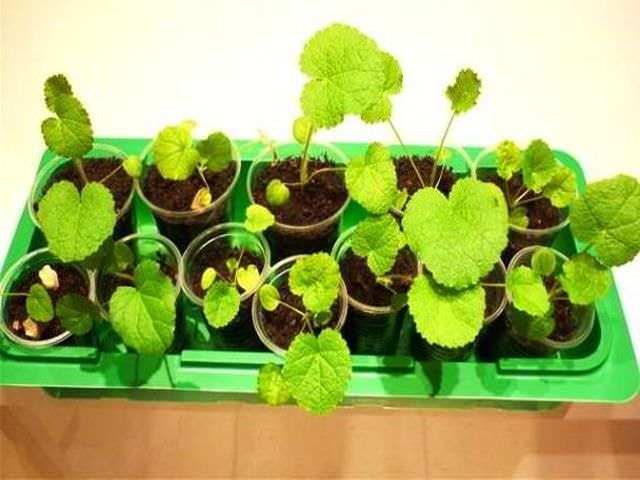

Important: Seeds that are two years old come and germinate best. To provoke germination, the seeds must be poured with warm water for 12 hours.
Diseases and pests
Rust
Mallow often suffers from rust (Puccinia malvacearum), which can destroy all plants. This is a fungal infection. Initial symptoms are small whitish warts on the stem and undersides of the leaves that turn brown over time, with yellow and red spots appearing on the leaves. The leaves turn brown, die off.
| Sign of the disease | Photo |
| Top side of the sheet |
|
| Bottom side of the sheet |
|
| Dying leaf |
|
If signs of rust appear, the leaves must be removed and burned immediately. Plants are sprayed with preparations: Saprol, Dithane Neotec 75 WG, Score 250 EC or Baymat AE.
Unfortunately, rust is deadly to plants, and its spores are capable of breaking through and attacking new shoots the next year. The only salvation is preventive sprays, which prevent rust. It is better not to wait for the appearance of the disease and from the beginning of May, every 2 weeks, spray the plants with the fungicides described above. A total of 4 treatments are carried out.
Excessive watering of plants, spraying leaves with water should be avoided.
Pests
Stockrose can fall prey to snails that love large, succulent leaves, and in the first year of growth, plants can destroy it completely. The snails are removed by hand or using products available from garden shops.


The plant can be damaged by an earthen flea (Podagrica fuscicornis). When it appears, they are treated with a pesticide, for example, Karate.
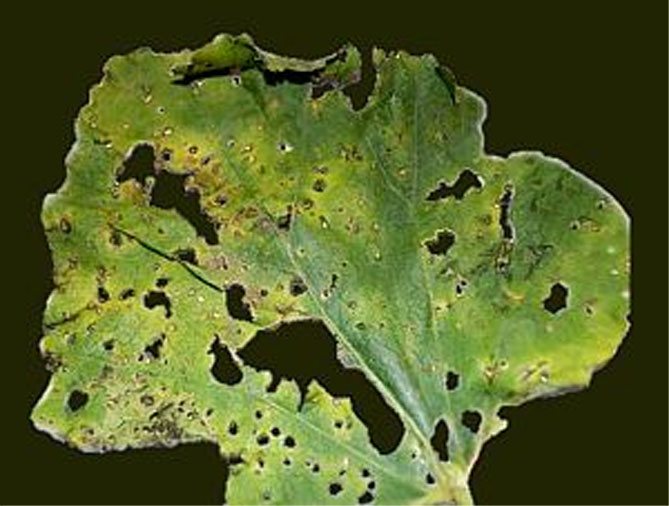

What does the science of botany say about this?
It so happened historically that in botany there is no absolutely harmonious, indisputable classification system (in other words - taxonomy) of plants, however, in order not to produce unnecessary entities, botanists agreed among themselves about the International Code of Botanical Nomenclature. A typical taxonomic series “from major unit to minor unit” is as follows: domain, kingdom, department, class, order, family, genus and species (possible additional and completely optional variations such as “superclass / subclass”, “superorder / suborder”, etc.) will be omitted for simplicity).
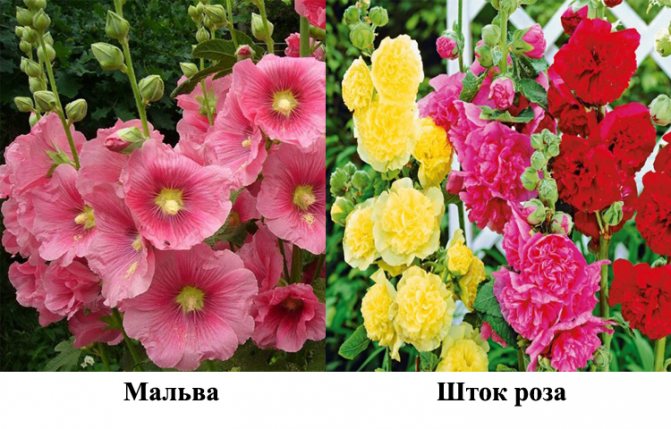

This hierarchy reflects the deep commonality of plants and animals: the domain of "eukaryotes" indicates that we are talking about living creatures with a cellular structure, in which the cell nucleus is clearly distinguished, and the taxon "kingdom" with the meaning of "plants" clearly indicates that it is about plants, not animals - and so on. With regard to the case of interest to us, the series will look as follows: domain - eukaryotes, kingdom - plants, department - flowering, class - dicotyledonous, order - malvaceae, family - mallow, genus - stockrose (the specific name of the species is omitted). By the names of the last three taxa, it is already becoming clear that confusion cannot be avoided "in everyday life" if you do not explicitly indicate - we are talking about a genus, family, or even the name of the species.
Application
Alcea rosea is a wonderful decoration for our gardens and has valuable medicinal properties.
Application in landscape
Mallow in the garden is a wonderful decoration that decorates walls and fences. So it is planted for practical reasons (so that it has support and protection from the wind), and aesthetic - tall, flowering stems can cover concrete or a fence mesh.
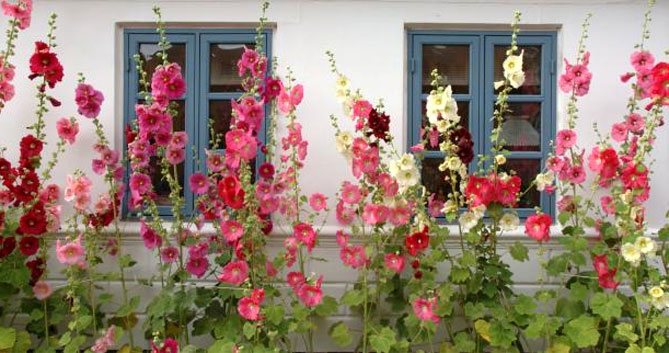

Stockrose grows most impressively in rows or groups that are not too close together.
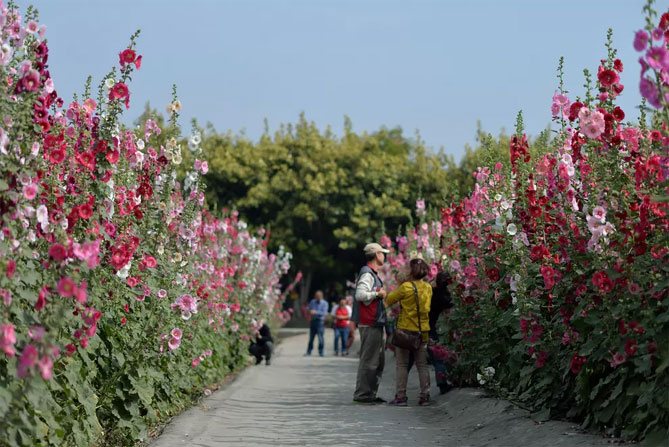

Stockroses are usually planted in groups of several plants as a dominant flower bed or a color addition to a composition. They are especially well represented next to tall roses, lavender, sunflowers and foxgloves.
Mallow are flowers that are hard not to love. Colorful, expressive, towering above the flower bed, they will be the perfect addition to any garden, even minimalistic. A wide range of varieties allows you to choose the perfect option for any style of landscape.
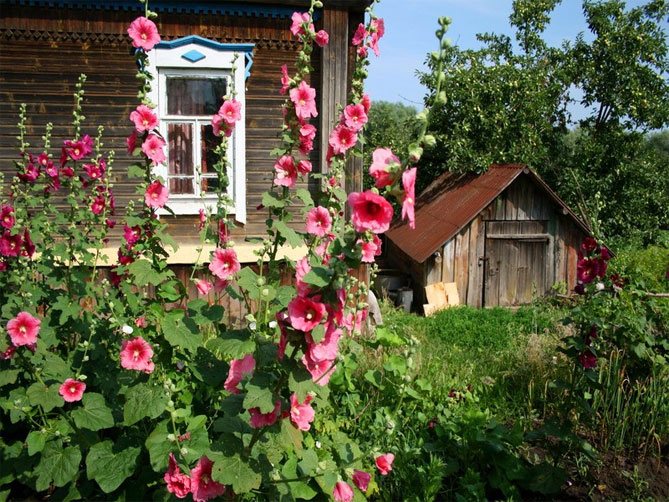

The hit of recent years is the extremely elegant and intriguing black stockrose, which looks beautiful against the background of light facades and concrete.


You can choose between low-growing varieties, reaching 60 cm (for example, the Spring Celebrities series), and tall ones with double or semi-double flowers in less common shades, for example:
- apricot Chater's Apricot,
- yellow-red Sunshine,
- white-pink "Creme de Cassis" Creme de Cassis.
Such noble varieties will delight even modern skeptics with their modernity!
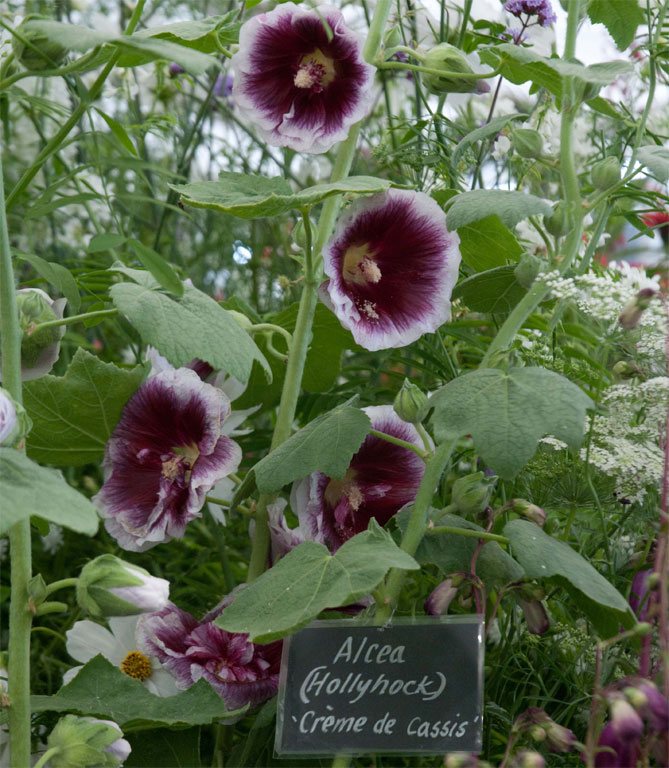

In medicine, cosmetology
Black mallow is the leader in medicinal uses.
The plant contains:
- rare anthocyanins,
- flavonoids,
- uronic acids,
- sugar alcohols,
- phytoestrogens,
- Sahara,
- tannins,
- phenolic resins,
- pectins,
- resin,
- mineral compounds.
The ingredients contained in mallow have anti-inflammatory, antipyretic, diuretic and antispasmodic effects.
Infusion of black mallow helps in the treatment of inflammation of the mucous membranes and upper respiratory tract. On the basis of mallow, syrups are produced that are useful in the treatment of colds.
Black mallow flowers are also used for:
- coloring in the food industry;
- Cosmetics industry - flower infusions are an ideal tonic for dry skin, treat acne, flaky skin, can delay the aging process.
Mallow infusion soothes irritations and moisturizes the skin.
Anthocyanins are natural plant dyes. Derived from mallow, they were once used to color sweets, cakes, textiles, and alcoholic beverages. The received colors from gray to blue-violet, shades of red. Today mallow no longer plays a big role in the production of dyes. However, roots, leaves and flowers are used successfully in herbal medicine.
Attention! Mallow should not be used by pregnant women - Black mallow can have quite strong diastolic effects. Therefore, pregnant women can only use it after consulting a doctor, as there is a risk of miscarriage.
Infusion of black mallow is useful for people with stomach diseases, irregular menstruation, and diseases of the bladder.
The use of roses in landscape design
Even the simplest stock-rose will serve as a garden decoration.
- She will be able to cover an unsightly fence, decorate the wall of a house or a barn.
- Planted in the background, it will create a beautiful backdrop for a flower garden. Modern colorful hybrids with double inflorescences justify the name of the flower - rose.
- Small varieties, such as Royal, can become the central part of the flower bed. The long blooming of the rose will make it decorative throughout the summer season.
- Plants with simple flowers will go well with ornamental grasses and low annuals, giving a rural flavor to the flower garden.
Such a multifaceted culture as the stock-rose will find application in any flower garden. This plant can no longer be called a rustic romantic flower.Modern hybrid varieties come in such a variety of shapes and colors that they can satisfy even the most sophisticated tastes. Despite this, the stock rose remains a plant that is not difficult to grow, and therefore a novice amateur gardener can decorate his garden with it.
Annual mallow
Annual varieties that are used in culture, in fact, refer to biennial plants. They are direct descendants of wild forest mallow. In nature, this plant has a stem from 40 to 100 cm long, and the flowers do not exceed five centimeters in diameter. Cultivated varieties with high, more than a meter stems. Popular varieties, the flowers of which are decorated with small veins.
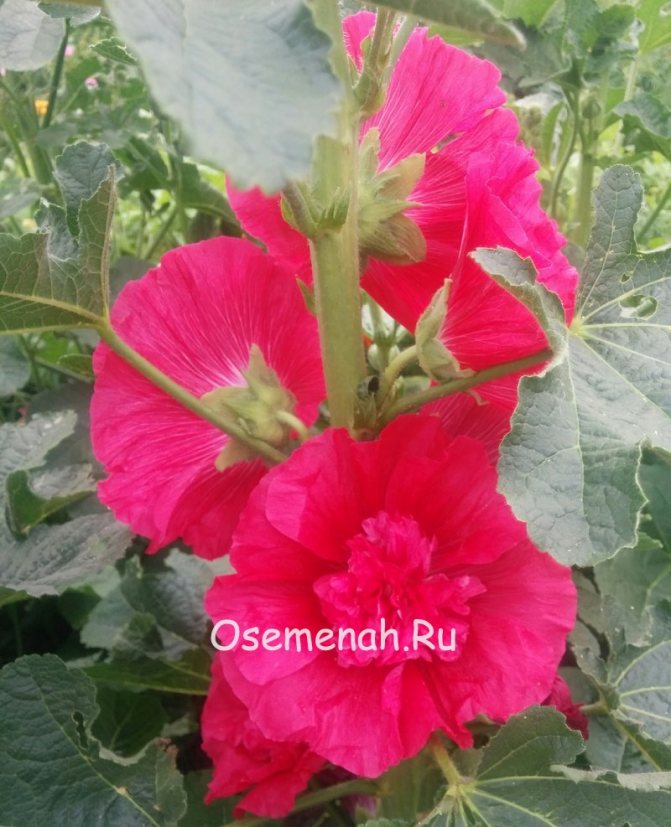

Flowers - stock rose
The decorative stem of the rose is a bush up to 2.5 m high, with heart-shaped serrated leaves on the stem. From the beginning of summer to the end of autumn, the plant forms solid spike-shaped inflorescences located along the entire length of the trunk. The flowers are very large, up to 12-13 cm in diameter, the shape of the corolla is bell-shaped. Rosettes are found semi-double, double and simple, in some varieties with ruffles and frills along the edge of the petals.
The color of the flowers is stunning - all tones of the reddish-yellow range, even lilac, purple, violet, black and red. The inflorescence blooms from bottom to top. The stock rose is actively used in landscape design, it becomes a decor for fences, walls, fences, arches, gazebos, it can be a hedge. It belongs to the Malvaceae family, it is the most beautiful representative of the species.
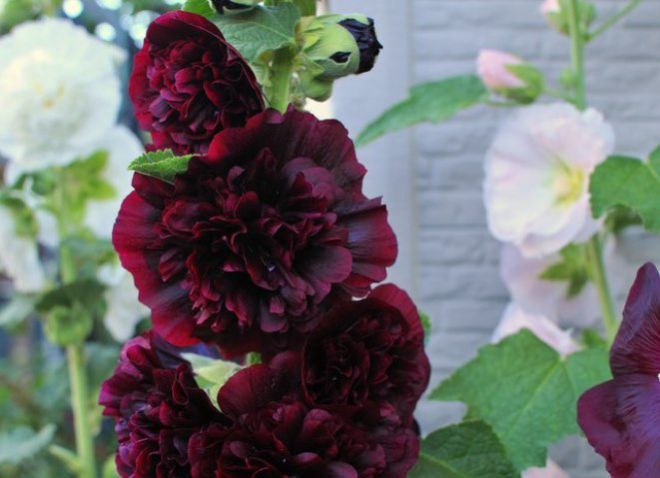

What is the difference between mallow and rose stem?
Many mallow (mallow) and the stem of the rose are considered one flower. But it is not so. They are assigned to the same family, but different genera and have certain characteristics. Stock rose and mallow - what is the main difference:
- The main difference is the lifespan of a culture. Stock rose is a biennial or perennial plant, about 80 types have been identified. In contrast, mallow is an annual crop.
- The height of the bush. The stem of the rose can reach 2.5 m in length, the mallow is much more modest - from 30 to 120 cm in height.
- Externally, the mallow differs from the stem of the rose with notched flower shapes and dissected leaves. Its corollas have cups with five petals, on which longitudinal stripes are clearly visible.
Video consultation
Audio article from the Florist-X blog.
Tips for florists
When growing in the garden various subspecies of annual, double or royal rose stock, you should pay attention to the advice of more experienced florists. Useful recommendations will help to achieve an earlier and more abundant flowering of mallow, keep seedlings and bushes healthy, and give the plant a more decorative look.
- It is advisable to use high grades for vertical decoration of garden arbors, hedges, fences, mixborders. If you plant a stem of a rose in the foreground or in the center of the flower bed, it will hide the rest of the flowers from your eyes.
- Annual mallow varieties should be sown in peat pots, greenhouses or hotbeds. After the emergence of seedlings and strengthening, they can already be transplanted into flower beds. Biennial and perennial hybrids should be sown directly into open ground.
- If you plant the bushes in the shade, they will grow, but the color of the flowers will be pale, and they themselves will crumble, become unattractive.
- Having planted several varieties with different colors next to each other in the garden, you can get new specimens with an unusual color, since the stem of the rose is capable of being pollinated.
- The first feeding should be carried out after planting the seedlings in the garden, the second - in mid-August. The plant responds best of all to universal complex or phosphorus-potassium fertilizers.
- For further reproduction of mallow, you can independently collect its seeds. The fruits are picked after they turn yellow. The boxes should be harvested from mid-summer until frost. Germination lasts 3 years.
- So that the perennial does not freeze out in winter, the broken off stems at the base are mulched with humus, sawdust, young plantings are covered with spruce branches.
Fertilizing and feeding mallow
If you want to improve the composition of the soil before planting mallow, mix the garden soil with humus and sand (in a ratio of 3: 2: 1). Add peat and wood ash there. For each bucket of soil mixture, you will need 1 glass of both. In addition, mulching with compost will improve the structure of poor soil.
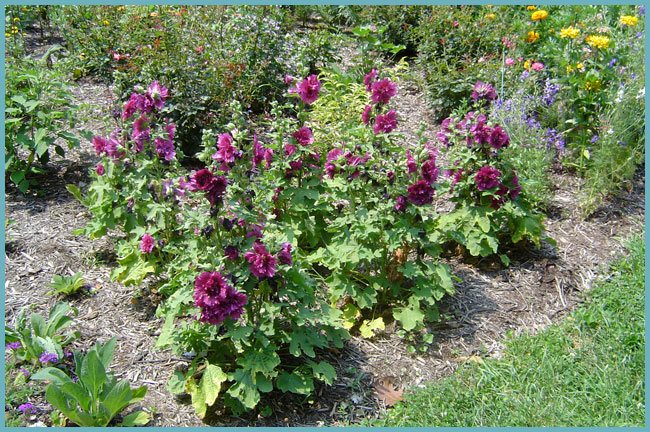

The plant will feel more comfortable if the soil is mulched.
The stock-rose needs additional nutrition in the second year of life. Top dressing is relevant during the period of active flowering. Use ready-made fertilizers that are dominated by potassium and phosphorus. Nitrogen abuse is bad for flowering.
Planting seeds for seedlings
For seedlings, stockrose seeds should be planted in March and early April. If you have to plant in greenhouses, you need to plant earlier - in February or early March. The seeds are prepared in the traditional way, soaking in warm water for 12 hours.
For planting, it is better to use separate pots, cups or containers, rather than shared boxes, since replanting from them can harm the plant. The root of the plant is rod-shaped, it will be more convenient for it to grow in a separate container, which is filled with nutritious soil from compost, peat, sawdust, turf, sand. The soil is moistened, seeds are sown, sprinkled with soil with a layer of 1 cm. Cover with a film on top to create a greenhouse effect inside.
Mallow "garland"
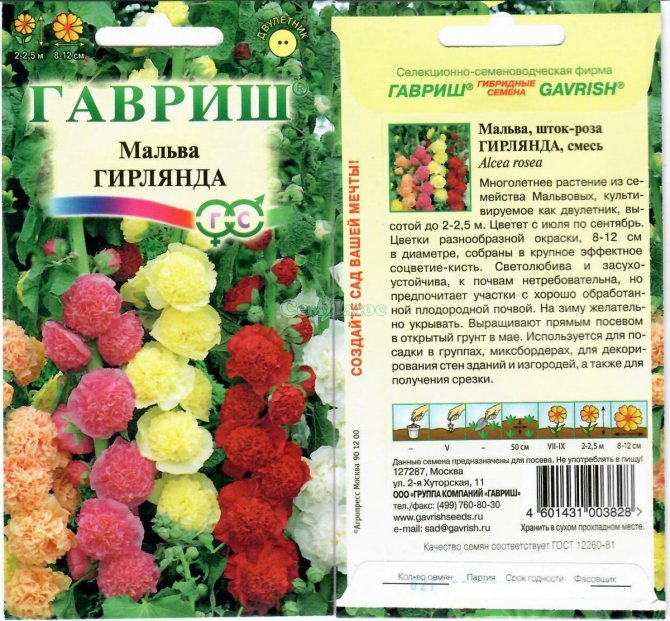

Mallow of the "Garland" variety is very decorative: abundant double flowers, similar to roses, are folded into spectacular rosettes. The height of this plant may well reach almost two meters, the features of the varieties are as follows:
- Peduncles grow from ground rosettes;
- Leaves - large and rough, with characteristic veins;
- The trunk is very powerful, it can withstand many buds and blooming flowers.
- Delicate petals of terry mallow varieties are white, pink, red, purple-black.
Description of culture (with photo)
Let's start a botanical description of the culture with such a simple fact: the stock-rose belongs to the Malvaceae family. The second (scientific) name for flowers is mallow (Malva), it is under this name that you can buy seeds in the store. In common parlance, culture is called mallow (for unknown reasons) or kalachik (obviously for the peculiar shape of the flower garden).
Differs in unpretentiousness and resistance to adverse environmental factors. It blooms even in very cold and rainy summers. Likewise, it tolerates drought and heat well.
More than 70 varieties and hybrid forms are known. Under natural conditions, it grows in warm regions of the planet.
It is divided into forms depending on a number of factors:
- annual, biennial or perennial culture;
- straight or sinuous, ascending or creeping stem;
- the height of an adult plant (miniature, dwarf, medium-sized and tall);
- terry (royal) or simple inflorescences.
Depending on the shape, the height of an adult plant can be from 30 cm to 2.5 meters, which makes it possible to use the culture both as a decoration for vertical surfaces, for example, fences, and for decorating borders.
The leaves have a dissected pinnate shape with slight pubescence, they can have up to 7 lobes. The buds themselves are laid and developed in the axils of the deciduous plate. They can be single or collected in inflorescences of 5 pieces. each bud has its own subchapter, consisting of pubescent matte stipules. Depending on the variety, the flower can be simple or double, with a diameter of 5 cm to 18 cm.The variety of colors is difficult to enumerate, since there are almost all the colors of the rainbow from yellow and white to purple and almost black.
The plant has a very powerful root system, extending in the form of a rod to a depth of 2 meters.Therefore, the stock rose is not afraid of any droughts and temperature drops. it winters well even in the Urals and Siberia with frosts down to minus 40 degrees Celsius.
The flowering period begins in mid-June and continues without interruption until the first snow falls or the onset of subzero night temperatures.
Look at the stock-rose in the photo, where mallows of different types and varieties are illustrated:
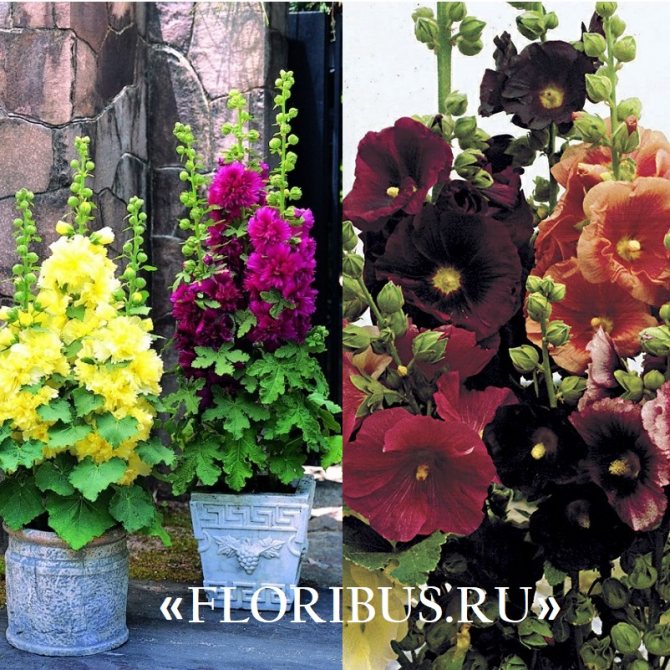

Terry mallow
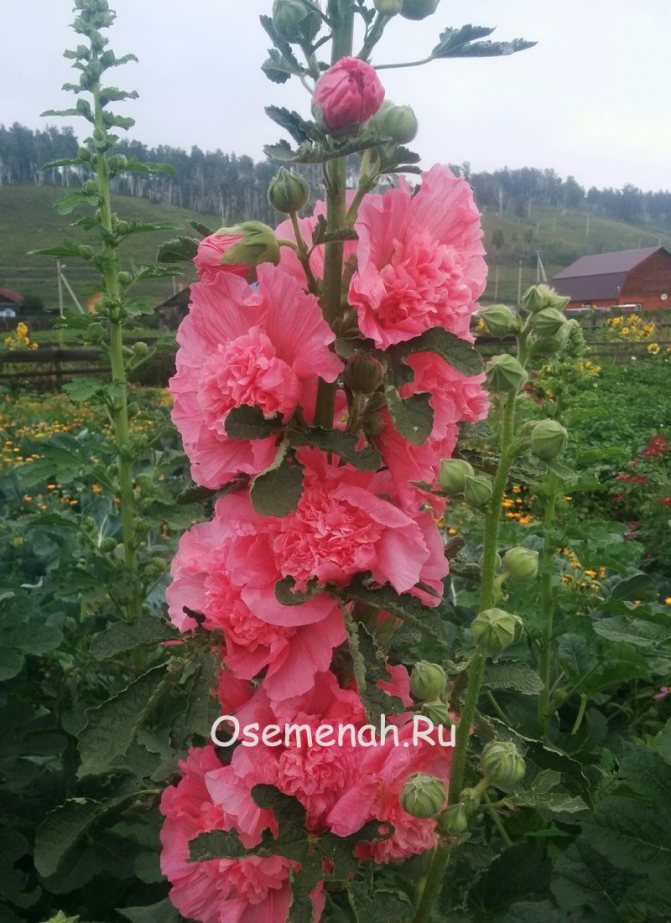

Crossbreeding by breeders of different varieties of mallow (for example, pink and wrinkled mallow) led to the emergence of beautiful varieties of hybrid mallow. It is this species that has varieties with spectacular double flowers in its collections. Amazing colors and unusual shades, ranging from bright white to delicate peach with bright pink inclusions, can decorate even a very modest garden. Reviews about mallow are the most positive.
Hybrid mallow varieties are also perennial crops.
They all have the following characteristic features:
- Height no more than 170 cm;
- The stems are large;
- The root gives rise to several stems;
- The bush is powerful and spreading.
Terry mallow varieties also begin to bloom in June, decorating the garden until autumn. True, in cold Russian regions they are forced to grow as annual varieties, but in the south, terry varieties are popular perennials.
Wrinkled mallow
Blooming mallow - photo:
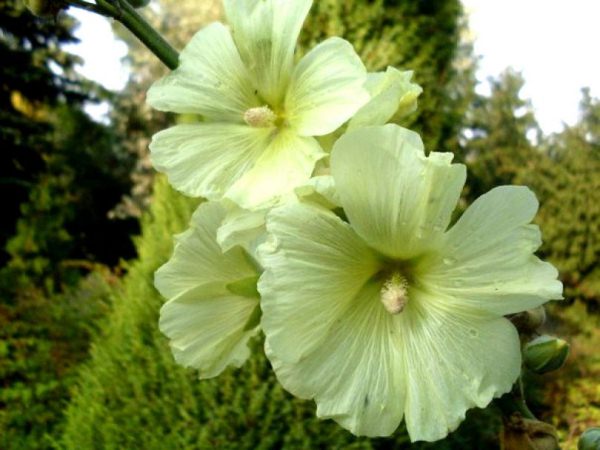

In recent years, this variety has become very popular due to its winter hardiness and unpretentiousness. A tall two-meter plant is very decorative, it adorns the garden with soft yellow corrugated large flowers.
Today in culture there are many spectacular hybrids that originated from pink mallow and wrinkled mallow.
Formation of culture
You need to water the sprouts constantly - 4 times a week. An adult plant is watered regularly, but without waterlogging the soil. You need to pour water at the root so as not to get on the leaves.
Gardeners tie tall crops to a peg. Old, faded, diseased parts are regularly cut off. Cleaning is carried out every 2-3 months during the flowering season, as the plant actively begins to shed its leaves at 2 years of age.
In autumn and spring, it is worth loosening the soil to provide the roots with access to air and moisture. The main task of the summer resident is not to damage the root system.
Important! Fertilize 2 times during the season. For feeding, a universal fertilizer is suitable - peat, humus, compost. The norm is 3 kg of organic matter per 1 m².
Gardeners reviews
Laura
This double stock rose is 4-5 years old. Grown from purchased seeds. When she grows up, someone mercilessly eats her leaves, but she grows new ones and blooms.
Azaliya, Kurgan
This year, for the first time, they sowed mallow with my mother, sowing was in early March in 0.5 liter glasses under film. Here's what happened. Variety "Lyubava"
How to collect mallow seeds
The seed bolls of Malva are formed after it has faded. It cannot be cut immediately, since the seeds must ripen, this process usually takes one month. Ripening sign - the capsule turns yellow. The seeds in a capsule lie around the pedicels. In order for the seeds to germinate next year, it is required to correctly collect and store them:
- Collecting seeds begins after opening the capsule.
- The seeds are dried for ten days at a temperature of about ten degrees.
- Seeds can be stored for several years in a dry and warm place.
However, if different varieties of mallow grow side by side in your garden, then, most likely, hybrids will grow from self-collected seeds. This phenomenon occurs because it is a cross-pollinated plant.
The stock rose is not only beautiful, but also useful plant roots are used as an expectorant, berries are used as food. In many countries, mallow is grown as a source of herbs, seasoning for main dishes.
Having picked up palettes of different shades and colors of mallow, you can create a very beautiful flower bed, cover up an old fence or a nondescript barn.So, if these beautiful flowers grow in your garden, then it will look elegant all summer long, the presence of this plant gives comfort and special flavor.
Where to plant?
When choosing a place for planting a stock-rose, it should be remembered that this plant is sun-loving, and abundant flowering is possible only in well-lit areas of the garden. This flower easily tolerates a slight drought, but excessive waterlogging and stagnant water may not survive.
This plant prefers loose, fertile and fertilized soils. Too heavy, as well as depleted soils with a small water content will lead to the death of the flower.
When thinking about the place where it is better to place the stem-rose, you should avoid windy places, as gusts can break tall stems.
How to care?
In the event that the stem-rose is planted in an open windy area, it is better to immediately foresee and install stakes to which high peduncles will be attached, thereby reducing the risk of their breakage. If the soil is fertile, then you should not carry out any special dressing. In the event that the soil is poor, then you can feed the stock-rose two weeks after transplanting (with complex mineral fertilizer), and then mulch the surface around the plant. Experts recommend the annual introduction of humus or compost into the soil, at the rate of 3 kg per square meter.
Seedling care


Care consists in moderate, regular watering, airing and hardening. After the emergence of seedlings, the shelter is removed. It is impossible to remove the film immediately, at first it is removed for 10 minutes, then for a longer period and so on until it is completely removed.
When the sprouts are stretched and pale in color, additional lighting is performed with a phytolamp. After the appearance of 3 main leaves, hardening is performed. For this, the room is ventilated, pots with plants are exposed for a couple of hours in a cool room (balcony, veranda).
Picking a rose stock is not desirable. If this procedure is necessary, sprouts with 3 main leaves are transplanted with an earthen clod.
The legend of the emergence of the mallow flower
When to plant a rose stock (growing from seed)
There are different legends about the appearance of the rose stock. One says that the beautiful girl Malva lived on a magic star. The young men tried to conquer her heart, but she gave it to Volodar. The love was mutual. The young people got married, lived happily, but soon the war began.
The girl waited for her lover for a long time, every day she went out on the road, outside the village, to call him. But Malva did not wait, she died. In the place where she had been waiting for him for days, a beautiful flower grew.


